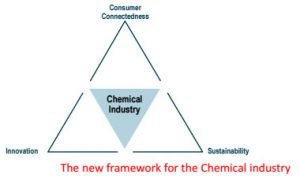6th September 2010, ECONOMIC TIMES
(Tell people that you work for a company in automotive, electronics or computing and they understand. Tell someone, “I work for a company that produces nitro-cellulose, surfactants and starch-based polymers”, and watch the clueless look. For the large part, chemical companies are faceless and incomprehensible.)
To emphasize how intimately chemicals touch our daily lives, I wrote an article titled, ‘Live one day without using chemicals’ (ET, 10th Nov 2008): from food, clothing, paints, fertilizers, medicine, cleaning products, to construction and transportation. The global chemical industry is a whopping $3.5 trillion, about 6 percent of world GDP. In India, the $83 billion chemical industry is as big as steel and auto together. Though the affairs of this industry are little understood, it should be of interest to many.
The chemical industry is at a fork in its journey. The industry has been single-mindedly obsessed with innovation. The results have been fabulous. To take just one example, the path-breaking ammonia synthesis process developed by Fritz Haber and Carl Bosch in 1909 for urea has resulted in enough food for today’s 6 billion. Arguably this is the technology that made the greatest difference to mankind in the last 100 years.
In the future, however, the industry has to balance innovation with consumer-intimacy and sustainability.
The image of chemicals
In addition to everyday products the industry also produces value-adding, industrial products: polymers, catalysts, coatings, petrochemicals. However, its consumer connectedness and environmental image are weak.
Two surveys illustrate the chemical industry’s lack of consumer connectedness and poor communications. In an image survey by TSMG, the auto industry conjured mobility and evoked feelings of speed, telecom connected with social warmth and communication, and IT associated with computation. The chemical industry evoked an unclear image with a negative hint. To the query on improving the quality of life, respondents admitted ignorance.
Tell people that you work in the automotive, electronics or computing industry and they understand. Tell someone, “I work for a company in the chemical industry that produces nitro-cellulose, surfactants and starch-based polymers”, and watch the clueless look.
A 2009 brand survey by Inter-Brand also reinforced the lack of consumer connectedness of the chemical industry. Almost every sector except chemicals finds a mention in the list of 100 leading global brands.
Explorers and farmers
Recently I had a philosophical conversation with the President and CEO of Kureha Corporation, Takao Iwasaki, a visionary technocrat. He was sure that the recent crisis and global concerns would trigger an ‘environmental technology revolution’ that would transform the industrial framework of the world.
But what might the new framework be? In my view, as shown in the chart, it means a triangulation of environmental sustainability, consumer-connectedness and innovation. Successful companies in all sectors are gravitating to this triangulated space.

Iwasaki-san said that there were two types of manufacturing companies or activities: hunters and farmers. A company may be one or the other; it may also combine the two types. I prefer the term ‘explorer’ rather than hunter.
Explorer companies produce consumer-facing products as Toyota, Sony and Kao do; consumers are their ‘finds’. Being consumer-oriented, explorers are sensitive to the behavioural patterns and expectations of consumers. They use creativity and ingenuity (read innovation) to capture as many finds as possible. Explorers are highly consumer-connected, B2C type companies.
Farmer companies are focused on what their land can produce. They sell to markets/customers rather than to end consumers. They monitor market prices and will grow/develop any new thing based on customer demands so long as their land (=technology) can do it. Through product advantage, they improve their customer’s offering to consumers. Farmer companies are customer-connected, or B2B companies.
Chemical industry
The chemical industry retains the appellation of chemistry unlike its peer sciences, which have not spawned physical, mathematical or biological industries! As the peer sciences evolved, they began to be recognized through their applications; for example, physics evolved into engineering, optics, and electronics. Biology manifested as medicine and animal health. Chemicals suffer from inadequate recognition, though the applications of chemistry are vibrant and diverse. Unlike other industry segments, the chemical industry sells as much as 80% of its output to B2B customers. For the large part, chemical companies are faceless and incomprehensible.
The chemical industry has too many farmers and too few explorers. Add to this, the occasional environmental damage, and chemicals become the number 1 villain of the future.
That is why the chemical industry is exploring a new positioning within the triangle of consumer connectedness, environment and innovation. Through bio and nanotechnology, the chemical industry can become benign in a transformational path.
Sustainability
Promoting sustainable approaches makes business sense. Sustainability calls for thought about the long-term implications of activities, and to measure the future performance of investment against environmental and social criteria apart from financial criteria. Sustainability means meeting needs of the present generation, without compromising ability of future generations to meet their needs.
ICIS conducted a study in 2009 which spanned over 900 respondents from the petrochemicals, specialty chemicals and polymer segments of the chemical industry, including CEOs. The good news was that the industry was aware about sustainability issues. The worrying news, however, was that most companies did not know what to do or had postponed actions due to more pressing matters.
In the ICIS survey, 60 percent of chemicals customers actually expressed interest in sustainably produced chemicals. However cost was perceived as the biggest prohibitive component of a sustainable program, followed by technical capabilities. Most CEOs in the developed countries worried that making their operations sustainable and developing green products might place them at a disadvantage vis-à-vis rivals in developing countries that don’t face the same pressure. Hence most executives treat the need to become sustainable as a corporate social responsibility, and not directly related to their business objectives.
A study by C. K. Prahalad, Ram Nidumolu and M. R. Rangaswami suggests that sustainability has successfully acted as a spur to profitable innovations. Becoming environment-friendly lowers costs because companies end up reducing the inputs they use. In addition, the process generates additional revenues from better products or enables companies to create new businesses. Smart companies increasingly treat sustainability as innovation’s new frontier.
Lenzing of Austria
Lenzing was set up in 1938, committed to natural fibres (like rayon) from wood pulp. They were pitted against giants like Courtalds and DuPont who made competing synthetic fibres, based on polymer chemistry. Lenzing focused on the consumer and environment by developing solvent-spinning to reduce the environmental damage that rayon-like products caused. In 2004, Lenzing bought Tencel technology developed by rival Courtalds. It is now a focused, highly successful environment-friendly cellulosic fibre company, offering absorbency that the synthetics do not offer—a delightful success story of sitting in the middle in the triangle.
Here is a four point future agenda for chemical companies:
- Communicate comprehensibly and reinforce consumer benefit even for B2B applications rather than industrial use. Achieve better recall and a relationship with the end consumer. If sufficient brand equity is established, this could even lead to ingredient branding.
- Focus on sustainability strategies. Emphasize water, energy conservation, reduced carbon footprints and ‘go green’. Even if some technologies are not viable currently, it is only a matter of time before there will be industry standards. Regulations should not be the sole reason to drive sustainability initiatives.
- Companies should track percentage of sales coming from new products or processes. Research teams should also be tracked on this measure to ensure that R&D spending is effective. Devote a part of R&D to efforts involving sustainability.
- Leverage next generation technologies like biotech and nanotech.



